Evidence for CDK-dependent and CDK-independent functions of the murine gammaherpesvirus 68 v-cyclin
- PMID: 17005668
- PMCID: PMC1676255
- DOI: 10.1128/JVI.01722-06
Evidence for CDK-dependent and CDK-independent functions of the murine gammaherpesvirus 68 v-cyclin
Abstract
Gamma-2 herpesviruses encode homologues of mammalian D-type cyclins (v-cyclins), which likely function to manipulate the cell cycle, thereby providing a cellular environment conducive to virus replication and/or reactivation from latency. We have previously shown that the v-cyclin of murine gammaherpesvirus 68 is an oncogene that binds and activates cellular cyclin-dependent kinases (CDKs) and is required for efficient reactivation from latency. To determine the contribution of v-cyclin-mediated cell cycle regulation to the viral life cycle, recombinant viruses in which specific point mutations (E133V or K104E) were introduced into the v-cyclin open reading frame were generated, resulting in the disruption of CDK binding and activation. While in vitro growth of these mutant viruses was unaffected, lytic replication in the lungs following low-dose intranasal inoculation was attenuated for both mutants deficient in CDK binding as well as virus in which the entire v-cyclin open reading frame was disrupted by the insertion of a translation termination codon. This replication defect was not apparent in spleens of mice following intraperitoneal inoculation, suggesting a cell type- and/or route-specific dependence on v-cyclin-CDK interactions during the acute phase of virus infection. Notably, although a v-cyclin-null virus was highly attenuated for reactivation from latency, the E133V v-cyclin CDK-binding mutant exhibited only a modest defect in virus reactivation from splenocytes, and neither the E133V nor K104E v-cyclin mutants were compromised in reactivation from peritoneal exudate cells. Taken together, these data suggest that lytic replication and reactivation in vivo are differentially regulated by CDK-dependent and CDK-independent functions of v-cyclin, respectively.
Figures

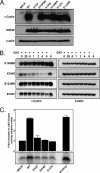
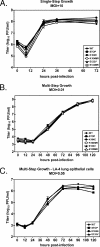
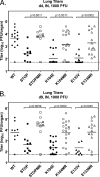
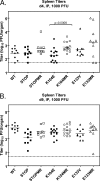
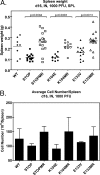

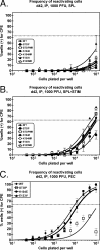
Similar articles
-
Characterization of murine gammaherpesvirus 68 v-cyclin interactions with cellular cdks.Virology. 2005 Oct 25;341(2):271-83. doi: 10.1016/j.virol.2005.07.014. Epub 2005 Aug 15. Virology. 2005. PMID: 16102793
-
The murine gammaherpesvirus 68 v-cyclin is a critical regulator of reactivation from latency.J Virol. 2000 Aug;74(16):7451-61. doi: 10.1128/jvi.74.16.7451-7461.2000. J Virol. 2000. PMID: 10906198 Free PMC article.
-
Ex vivo stimulation of B cells latently infected with gammaherpesvirus 68 triggers reactivation from latency.J Virol. 2005 Apr;79(8):5227-31. doi: 10.1128/JVI.79.8.5227-5231.2005. J Virol. 2005. PMID: 15795307 Free PMC article.
-
The cell cycle, cyclin-dependent kinases, and viral infections: new horizons and unexpected connections.Prog Cell Cycle Res. 2003;5:103-24. Prog Cell Cycle Res. 2003. PMID: 14593705 Review.
-
Cellular proteins (cyclin dependent kinases) as potential targets for antiviral drugs.Antivir Chem Chemother. 2001;12 Suppl 1:157-78. Antivir Chem Chemother. 2001. PMID: 11594683 Review.
Cited by
-
Interplay of Murine Gammaherpesvirus 68 with NF-kappaB Signaling of the Host.Front Microbiol. 2016 Aug 17;7:1202. doi: 10.3389/fmicb.2016.01202. eCollection 2016. Front Microbiol. 2016. PMID: 27582728 Free PMC article. Review.
-
Viral cyclins mediate separate phases of infection by integrating functions of distinct mammalian cyclins.PLoS Pathog. 2012 Feb;8(2):e1002496. doi: 10.1371/journal.ppat.1002496. Epub 2012 Feb 2. PLoS Pathog. 2012. PMID: 22319441 Free PMC article.
-
Targeted therapy for Kaposi's sarcoma and Kaposi's sarcoma-associated herpesvirus.Curr Opin Oncol. 2007 Sep;19(5):452-7. doi: 10.1097/CCO.0b013e3281eb8ea7. Curr Opin Oncol. 2007. PMID: 17762570 Free PMC article. Review.
-
Phosphoproteomic analyses reveal signaling pathways that facilitate lytic gammaherpesvirus replication.PLoS Pathog. 2013 Sep;9(9):e1003583. doi: 10.1371/journal.ppat.1003583. Epub 2013 Sep 19. PLoS Pathog. 2013. PMID: 24068923 Free PMC article.
-
ORF73-null murine gammaherpesvirus 68 reveals roles for mLANA and p53 in virus replication.J Virol. 2007 Nov;81(21):11957-71. doi: 10.1128/JVI.00111-07. Epub 2007 Aug 15. J Virol. 2007. PMID: 17699571 Free PMC article.
References
-
- Adler, H., M. Messerle, and U. H. Koszinowski. 2003. Cloning of herpesviral genomes as bacterial artificial chromosomes. Rev. Med. Virol. 13:111-121. - PubMed
-
- Arellano, M., and S. Moreno. 1997. Regulation of CDK/cyclin complexes during the cell cycle. Int. J. Biochem. Cell Biol. 29:559-573. - PubMed
Publication types
MeSH terms
Substances
LinkOut - more resources
Full Text Sources

